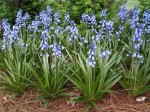 When I first grew Spanish bluebells they were called Scilla or Wood Squill and, in fact, many bulb catalogues list them with scillas. The Spanish bluebells are taller and bloom later than most scillas. The late spring bloom time is always welcome in my garden because my other spring bulbs have finished blooming and my annuals and perennials have not really hit their stride yet. The informal growth habit of the Spanish bluebells is especially pleasing in woodland gardens and naturalized areas but are also attractive in borders and rock gardens. They are tough plants and do well in a variety of sites, so well, in fact, that in England they are pushing out the English bluebell.
When I first grew Spanish bluebells they were called Scilla or Wood Squill and, in fact, many bulb catalogues list them with scillas. The Spanish bluebells are taller and bloom later than most scillas. The late spring bloom time is always welcome in my garden because my other spring bulbs have finished blooming and my annuals and perennials have not really hit their stride yet. The informal growth habit of the Spanish bluebells is especially pleasing in woodland gardens and naturalized areas but are also attractive in borders and rock gardens. They are tough plants and do well in a variety of sites, so well, in fact, that in England they are pushing out the English bluebell.
Type: Spring bulb.
Bloom: Twelve or more lavender blue nodding flowers are loosely borne around the 12” high stem above strap shaped leaves in late spring. Cultivars are available in pink, white and various shades of blue.
Size: 8-18” H.
Light: Full sun to part shade.
Soil: Average, medium, well-drained soil.
Hardiness: Zones 3-8.
Care: Plant bulbs 3-4’ deep and 4-6” apart and top dress with bulb booster in fall. Let foliage die after flowering before removing.
Pests and Diseases: None of significance.
Propagation: Division of bulbs after flowering; self seed.
Companion plants: Azaleas, ajuga, old fashioned bleeding heart, Japanese painted fern.
Outstanding Selections: ‘Excelsor’ (violet blue); ‘Danube’ (dark blue) ‘Rosabella’ (violet pink), ‘Rose Queen’ (rose-pink), and ‘White Triumphator’ (white).
